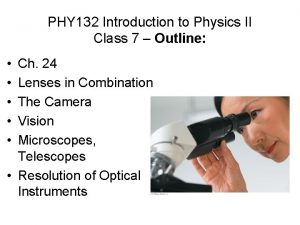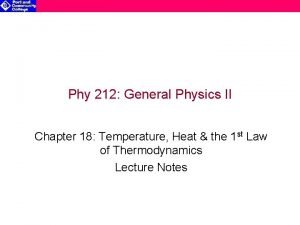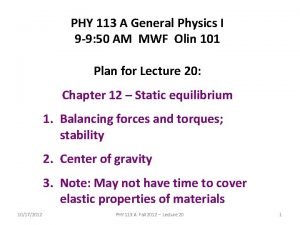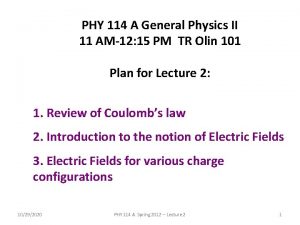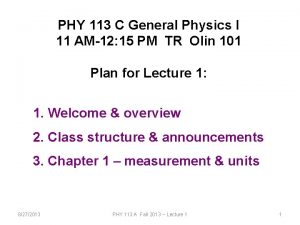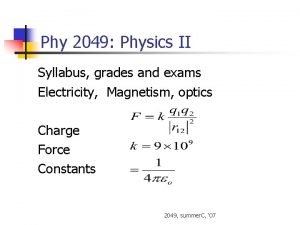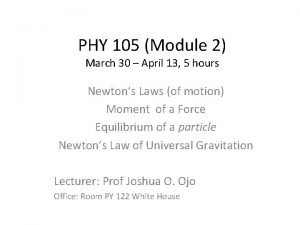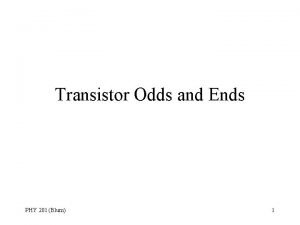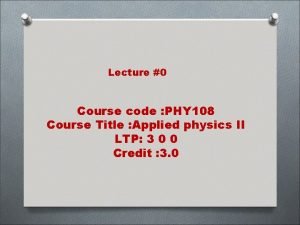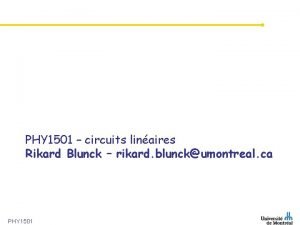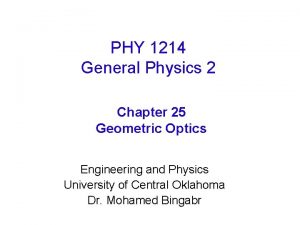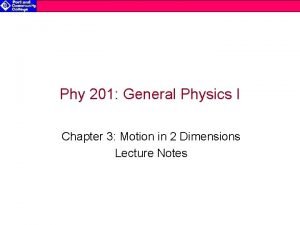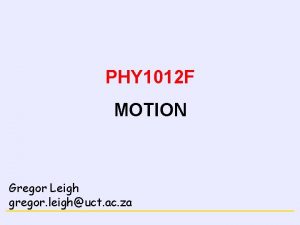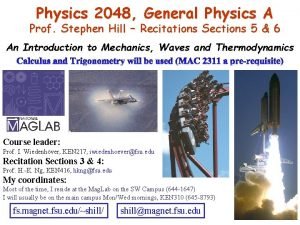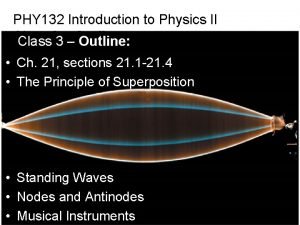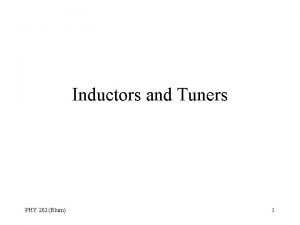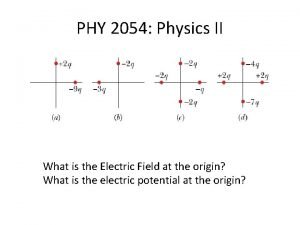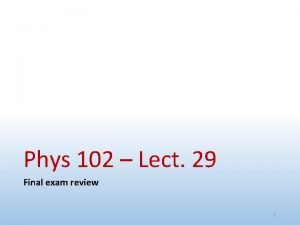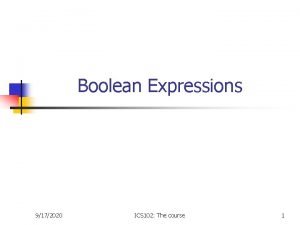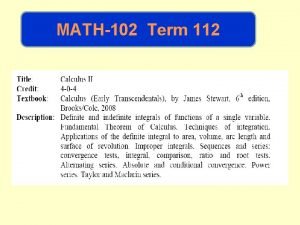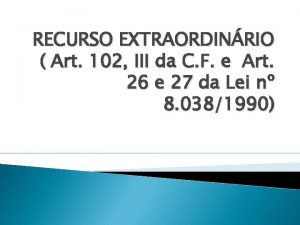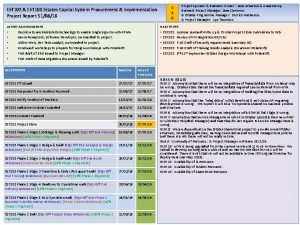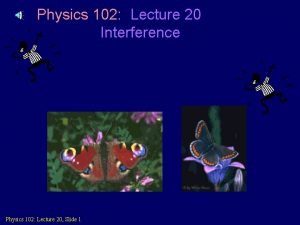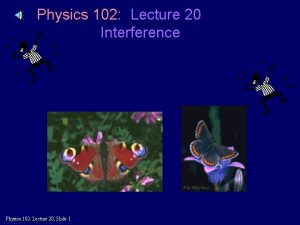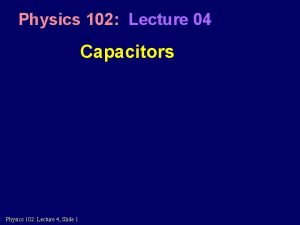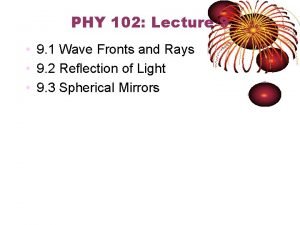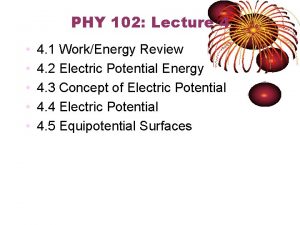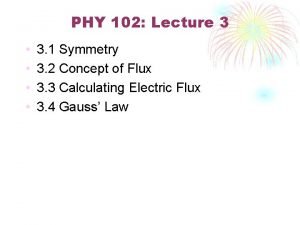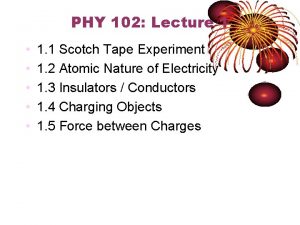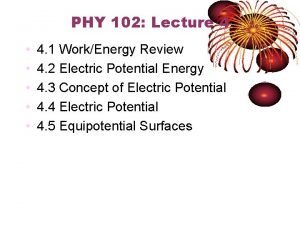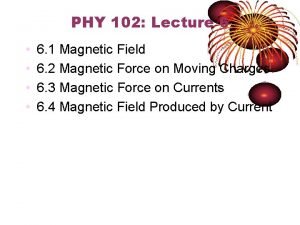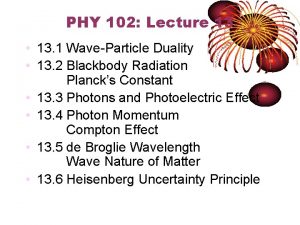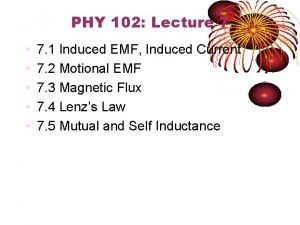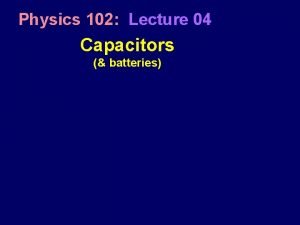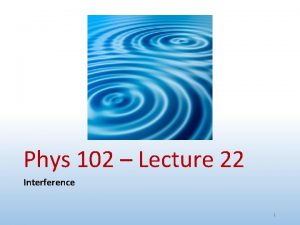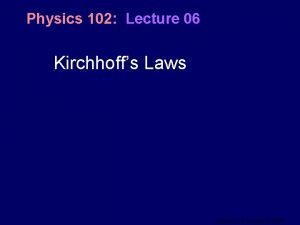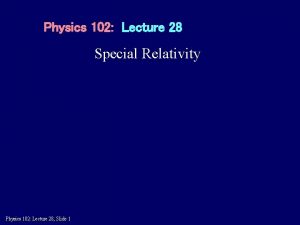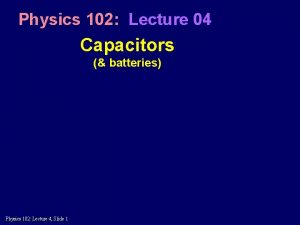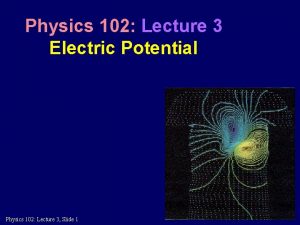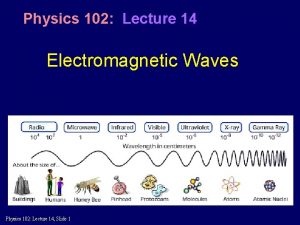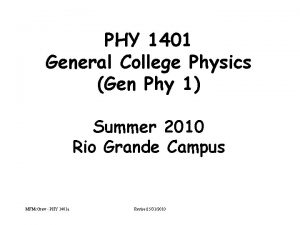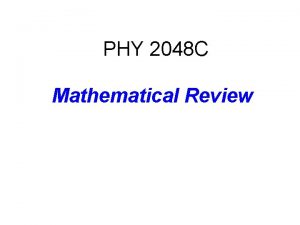PHY 102 Lecture 10 10 1 10 2





















































- Slides: 53

PHY 102: Lecture 10 • • • 10. 1 10. 2 10. 3 10. 4 10. 5 10. 6 Index of Refraction Total Internal Reflection Prism and Rainbows Lenses Formation of Images Lens Equations

PHY 102: Lecture 10 Refraction of Light 10. 1 Index of Refraction

Index of Refraction • • • Speed of light in vacuum is c = 3. 00 x 108 m/s Light travels through many materials - air, water, glass Atoms in the material absorb, reemit, and scatter light Light travels through the material at a speed less than c The actual speed depends on the nature of the material The change in speed as a ray of light goes from one material to another causes the ray to deviate from its incident direction • This change in direction is call refraction • Index of refraction describes the extent to which speed of light in a material differs from that in a vacuum

Definition of Index of Refraction • • n is the index of refraction of a material n = Vacuum light speed / Material light speed n = c/v n of vacuum is 1. 00

Index of Refraction of Materials

Refraction - 1 • Light strikes the interface between two transparent materials, such as air and water • Light divides into two parts • Part of the light is reflected, with the angle of reflection equaling the angle of incidence • The remainder is transmitted across the interface • If the incident ray does not strike the interface at normal incident, the transmitted ray has a different direction than the incident ray

Refraction - 2 • The ray that enters the second material is said to be refracted and behaves in one of two ways 1. When light travels from a medium where the refractive index is smaller into a medium where it is larger, the refracted ray is bent toward the normal 2. When the light travels from a medium where the refractive index is larger into a medium where it is smaller, the refracted ray is bent away from normal

Refraction - 3 • • In both parts of the figure the angles of incidence, refraction, and reflection are measured relative to the normal The index of refraction of air is labeled n 1 in part a It is n 2 in part b We label all variables associated with the incident (and reflected) ray with subscript 1 and all variables associated with the refracted ray with subscript 2

Snell’s Law • Light travels from a material with refractive index n 1 into a material with refractive index n 2 • The refracted ray, the incident ray, and the normal to the interface between the materials all lie in the same plane • The angle of refraction 2 is related to the angle of incidence 1 by • n 1 sin 1 = n 2 sin 2

n Depends on Angle of Incidence • Principle of conservation of energy • Energy reflected plus energy refracted must equal energy of incident light • If there is no absorption by material • Percentage of incident energy that is reflected versus refracted light depends on – Angle of incidence – Refractive indices of materials

Amount of Reflection for different angles of incidence for plate glass • Surfaces that both reflect and transmit light – Light perpendicular to surface (angle of incidence = 00) reflects the least – Amount of reflection increases as angle of incidence increases towards 900

Index of Refraction by Wavelength

Problem 1 • • • The incident ray is in air 1 = 460 and n 1 = 1. 00 The refracted ray is in water n 2 = 1. 33 Find 2 üsin 2 = n 1 sin 1/n 2 = (1. 00)sin 46/1. 33 = 0. 54 ü 2 = sin-1(0. 54) = 320

Apparent Depth • When rays entering the air are extended back into the water they indicate that the observer sees a virtual image of the chest at an apparent depth that is less than the actual depth

Apparent Depth from Directly above Object • d’ = d(n 2 / n 1)

Problem 2 • A swimmer is treading water (head above water) at the surface of a pool 3. 00 m deep • She sees a coin on the bottom of the pool directly below her • How deep does the coin appear to be? üd’ =d(n 2/n 1) = (3. 00 m)(1. 00/1. 33) = 2. 26 m

Displacement of Light by a Transparent Slab of Material • A windowpane is a transparent slab of glass • It consists of a plate of glass with parallel surfaces • When a ray of light passes through the glass, the ray emergent ray is parallel to incident ray but displaced from it

PHY 102: Lecture 10 Refraction of Light 10. 2 Total Internal Reflection

Total Internal Reflection - 1 • Light passes from a medium of larger refraction index into one of smaller refraction index (water to air) • Refracted ray bends away from the normal • As the angle of incidence increases , the angle of refraction also increases

Total Internal Reflection - 2 • When the angle of incidence reaches a certain value called critical angle c the angle of refraction is 900 • Then the refracted ray points along the surface

Total Internal Reflection - 3 • When the angle of incidence exceeds the critical angle, there is no refracted light • All the incident light is reflected back into the medium from which it came • This is called total internal reflection

Total Internal Reflection - 4 • The total reflection occurs only when light travels from a higher index medium toward a lower index medium • It does not occur when light propagates in the reverse direction

Critical Angle • sin c = n 2 / n 1 where (n 1 > n 2)

Problem 3 -1 • A beam of light is propagating through diamond (n 1 = 2. 42) and strikes a diamond -air interface at an angle of incidence of 280 • Will part of beam enter the air (n 2 = 1. 00) or will the beam be totally reflected at the interface? ü c = sin-1(n 2/n 1) ü c = sin-1(1. 00/2. 42) = 24. 40

PHY 102: Lecture 10 Refraction of Light 10. 3 Prisms and Raindows

Monochromatic Light Through Prism • Ray of monochromatic light passes through a glass prism • Prism is surrounded by air • When the light enters the prism the refracted ray is bent toward the normal • Refractive index of glass is greater than that of air • When the light leaves the prism it is refracted away from the normal

Colored Light Through Prism • Refractive index of glass depends on wavelength • Rays corresponding to different colors are bent by different amounts by the prism • They depart in different directions • The greater the index of refraction the greater the bending This is known as dispersion

Indices of Refraction of Crown Glass

Rainbows - 1 • Light from the sun enters a spherical raindrop • Light of each color is refracted by an amount that depends on the refractive index of water for that wavelength

Rainbow - 2 • Light is reflected from the back surface of the droplet • Then the different colors are again refracted as they reenter the air • Each droplet disperses the light into its full spectrum of colors • The observer sees only one color of light coming from any given droplet

PHY 102: Lecture 10 Refraction of Light 10. 4 Lenses

Lens Focal Point F - 1 • Paraxial rays are near the principal axis of lens • Paraxial rays parallel to the principal axis converge to a single point on the axis after emerging from the lens • This point is called the focal point F of the lens • An object located infinitely far away on the principal axis leads to an image at the focal point of the lens • Focal length f is distance from the focal point to the lens

Lens Focal Point F - 2 • We assume that the lens is so thin compared to f that it makes no difference whether f is measured between the focal point and either surface of the lens or center of the lens

Converging Lens • This type of lens is a converging lens or convex lens • It causes incident parallel rays to converge at the focal point

Diverging Lens • Diverging lens or concave lens causes incident parallel rays to diverge after exiting the lens • Paraxial rays that are parallel to the principal axis appear to originate from a single point on the axis after passing through the lens • This point is the focal point F

PHY 102: Lecture 10 Refraction of Light 10. 5 Formation of Images

Ray Diagrams

Ray Tracing – Converging Lens • Ray 1 • Ray initially travels parallel to the principal axis. In passing through a converging lens, the ray is refracted toward the axis and travels through the focal points on the right side of the lens • Ray 2 Ray first passes through the focal point to the left and then is refracted by the lens in such a way that it leaves traveling parallel to the axis • Ray 3 • Ray travels directly through the center of the thin lens without any appreciable bending

Ray Tracing – Diverging Lens • Ray 1 • Ray initially travels parallel to the principal axis. In passing through a diverging lens, the ray is refracted away from the axis, and appears to have originated from the focal point on the left of the lens. The dashed line represents the apparent path of the ray • Ray 2 • Ray leaves the object and moves toward the focal point on the right of the lens. Before reaching the focal point, however, the ray is refracted by the lens so as to exit parallel to the axis. The dashed line indicates the ray’s path in the absence of the lens • Ray 3 • Ray travels directly through the center of the thin lens without any appreciable bending

Image Formed – Converging Lens - 1 • Object is before 2 F, the image is real, inverted, and smaller than the object • The image is beyond F

Image Formed – Converging Lens - 2 • Object between 2 F and F, the image is real, inverted and larger than the object • The image is beyond F

Image Formed – Converging Lens - 3 • Object between F and the lens, the image is virtual

Image Formed – Diverging Lens • The image is virtual, upright and smaller than the object

PHY 102: Lecture 10 Refraction of Light 10. 6 Lens Equations

Lens Equation Geometry

Lens Equation - Distance do is distance of object from lens di is distance of image from lens f is focal length + for converging (convex) lens – for diverging (concave) lens

Example Lens Equation - Distance Focal lens of convex lens is f = + 4 cm Object is located at do = 10 cm What is location of image, di? (1/10) + (1/di) = ¼ 0. 10 + (1/di) = 0. 25 1/di = 0. 25 – 0. 10 = 0. 15 di = 1/0. 15 = 6. 67 cm Positive image distance means image is “real”

Example Lens Equation - Distance Focal lens of concave lens is f = - 4 cm Object is located at do = 10 cm What is location of image, di? (1/10) + (1/di) = -¼ 0. 10 + (1/di) = -0. 25 1/di = -0. 25 – 0. 10 = -0. 35 di = -1/0. 35 = -2. 86 cm Negative image distance means image is “virtual”

Lens Equation – Size or Magnification • magnification = Positive magnification means upright image Negative magnification means inverted image

Example Magnification Equation Focal lens of convex lens is f = + 4 cm Object is located at do = 10 cm Image is located at di = 6. 67 cm Magnification = - 6. 67 / 10 = - 0. 67 The image is inverted and smaller

Example Magnification Equation Focal lens of concave lens is f = - 4 cm Object is located at do = 10 cm Image is located at di = -2. 87 cm Magnification = - (-2. 86) / 10 = + 0. 29 The image is upright and smaller

Convex Lens Chart Object Image Location Image Size Upright Inverted Real Virtual > 2 f >f Smaller Inverted Real = 2 f Same Inverted Real 2 f to f >2 f Larger Inverted Real =f Infinity - - - <f - Larger Upright Virtual

Concave Lens Chart Object Image Location Any where - Image Size Upright Inverted Real Virtual Smaller Upright Virtual
 Transopia
Transopia 01:640:244 lecture notes - lecture 15: plat, idah, farad
01:640:244 lecture notes - lecture 15: plat, idah, farad Ddr phy architecture
Ddr phy architecture Phy 212
Phy 212 2012 phy
2012 phy Phy 131 past papers
Phy 131 past papers Phy
Phy Physics 2
Physics 2 Phy 1214
Phy 1214 Life phy
Life phy Phy theorem
Phy theorem Phy 2049
Phy 2049 Phy-105 5 discussion
Phy-105 5 discussion Phy 205
Phy 205 General physics 1 measurements
General physics 1 measurements Phy 110
Phy 110 Pa msu
Pa msu Phy
Phy Phy 108
Phy 108 Phy
Phy Phy1501
Phy1501 Phy113
Phy113 Phy 1214
Phy 1214 Eye phy
Eye phy Phy 1214
Phy 1214 Phy
Phy Great orthogonality theorem proof
Great orthogonality theorem proof Atm basics
Atm basics Phy tgen
Phy tgen Phy 131 asu
Phy 131 asu Loncapa fsu
Loncapa fsu Applications of magnetism
Applications of magnetism Phy 1214
Phy 1214 Phy 2049
Phy 2049 Phy 132
Phy 132 Phy
Phy Phy 221 msu
Phy 221 msu Fizik ii
Fizik ii Jeevan kishore with profits
Jeevan kishore with profits Physics 102 electricity and magnetism
Physics 102 electricity and magnetism Ecs comp102
Ecs comp102 Egee 102 home activity 4
Egee 102 home activity 4 Article 102
Article 102 Iat 102
Iat 102 Physics 102 final exam
Physics 102 final exam Ics 102
Ics 102 Bisp 195 ucsd
Bisp 195 ucsd Service symbols
Service symbols Math 102 kfupm
Math 102 kfupm Convenio 102
Convenio 102 Cf art 102
Cf art 102 Est 103
Est 103 Physics 102
Physics 102 Fitness 102
Fitness 102
